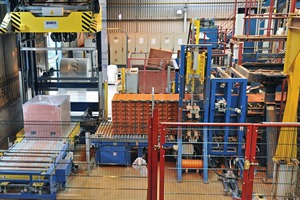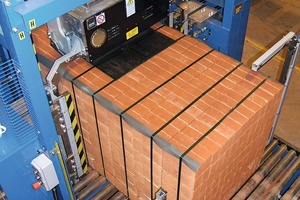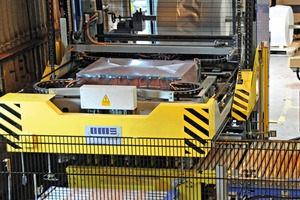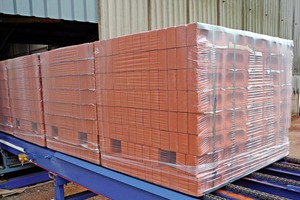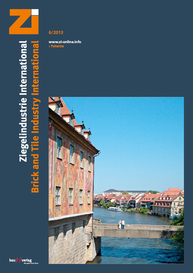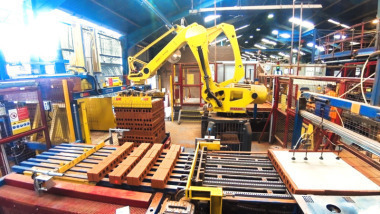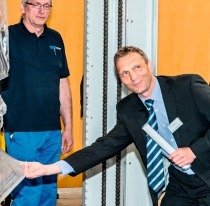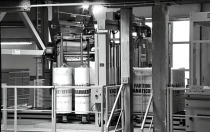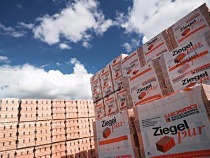Ibstock, one of the UK’s leading clay brick manufacturers, recently installed a new stretch hooding machine at its Ellistown plant to replace its existing shrink hooding machine, which was over 20 years old and obsolete. When used in conjunction with plastic straps, the hood lends stability to the brick pack. The new OMS IS43 Stretch Hooder was installed by Gordian Strapping Ltd, a 100-% subsidiary of Strapack Corp. of Japan. Gordian Strapping is the exclusive representative for OMS in the UK and Ireland and, with its team of 13 engineers, it is also responsible for service and maintenance.
The packs of bricks come direct from the strapping system to the new OMS IS43 stretch hooder. This applies stretch hoods (clear or printed) to up to 60 packs/hour. In the case of printed film, a print mark is used to ensure the logo is in the same position on every pack.
Ibstock’s decision to replace their shrink hooder with a stretch hooder was based on several factors:
› �Cost savings thanks to the elimination of gas usage
› �Opportunity to reduce cost of packaging by using a lower-gauge film
› �Elimination of any risk of packs catching fire
› �Improved health and safety, and environmental protection
Shrink and stretch hooding: comparison of films and machinery
Shrink hooding involves applying a heat-shrinkable, gusseted polyethylene bag to a pack and then shrinking it to the pack using hot air emitted from gas burners (LPG or natural gas). The flame on modern machines is only ignited during the shrinking operation. This ensures a considerable energy saving compared to earlier technology, where burners on some models were on during the whole production shift, regardless of whether the hooder was operating. Modern machines also use enclosed hot air burners. The burners on some older models are not enclosed, meaning that if the hood is poorly positioned the flame can come into contact with it, causing the pack to catch fire.
Stretch hooding involves applying a stretchable, gusseted polyethylene bag to a pack, but without using gas burners. While shrink film consists of a single layer, stretch film is a 3-layer co-extruded film. With both systems, gusseted film is supplied on a reel. The machine then draws the film from the reel to the desired length, welds and then cuts it to form the hood. The hood is then lowered over the pack until the machine releases it at the desired position (usually at conveyor level).
Modern stretch hooders have the following advantages over shrink hooders:
› �As no gas connection is needed, the machine can be installed anywhere in the factory
› �Saving on the cost of gas itself – around 4 500 to 5 500 €/year and improvement of the plant’s overall carbon footprint
Most shrink hooders blow air into the bags to help open them. Although most film suppliers use anti-static agents to try to prevent the film sticking together, it can become affected by static in the atmosphere as it is drawn off the reel, making it hard to open the hood. Modern stretch hooders open the bags mechanically, which overcomes static build-up, eliminating the need to blow air into the bags and consequently the risk of dust.
Stretch hooders: specifications and ancillary equipment
Modern stretch hooders are very compact machines and can be integrated into existing lines in just a few days. The footprint of the single-film reel holder machine at Ibstock Ellistown is L x W x H 5 000 mm (arch extended) x 2 500 mm x 4 500 mm. If required, an additional film reel holder can be supplied which provides the option to put a different size film on each reel, or plain film on one reel and printed film on the other (which reduces downtime when changing reels). All machine functions and settings are easily accessible and operated via an HMI. Energy consumption is typically around 0.05 KWh per pallet, and noise levels on some machines are < 70 dB. The following ancillary equipment may be required: new conveyors or conveyor sections, a lifting device (to secure the film beneath the pack if required) or a turntable (to ensure that any logo faces the right way round on the pack).
Film usage and cost
Stretch hooding uses 25– 30% less film per pack than shrink hooding to wrap the same product (based on the same gauge of film). So although stretch film costs around 20% more per tonne than shrink film (approx. 2 299 €/t versus 1 800 €/t at today’s prices for unprinted film), in real terms the cost per pack is the same or lower when stretch hooded.
Furthermore, new lower gauges of film offer additional savings, while still ensuring well-presented and secure packs. For example, by moving from a higher-gauge shrink film (100– 120 µm) to a lower-gauge stretch film (60– 80 µm), many companies calculate a saving of around € 37 500/year (depending on the gauge, the price of the film and the quantity of packs being produced). Further film savings can be made by applying a sleeve (a band of film around the pack which leaves the top of the pack exposed), or a shorter hood.
Advantages of the OMS IS43
The OMS IS43 places the hood onto the pack inside out. Not only is the logo protected from the elements, but the gusset corners, i.e. the flaps formed when the film is welded, are on the inside of the hood meaning that the top of the pack is perfectly flat.

